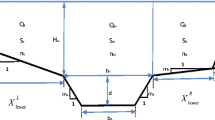Abstract
Traditional dam safety assessment tends to place the focus on estimating the probabilities of failure for the system based on a few subjectively-chosen operating scenarios. The techniques used to assess these systems rely on linear chains of events and are incapable of considering component interactions, feedbacks and non-linear behaviour. This paper uses a systems approach to develop a new technique that puts possibilities first and is capable of generating an exhaustive list of potential component operating state scenarios for the system. The scenarios can then be simulated using a Monte-Carlo approach to determine a wide range of system behaviour (outcomes) for each scenario, taking into account component interactions and feedbacks. A component operating states database is presented where the system can be broken down into various levels of detail and the operating states and causal factors for each component can be defined. The Cartesian product of each operating state set is used to derive the full range of potential operating scenarios, with each scenario consisting of a single operating state for every component in the system. The list of scenarios can be used as an input to a simulation model which can then be run many times for each scenario, using Monte-Carlo inputs which vary the timing and severity of events as well as the inflows. The approach for automated scenario generation is demonstrated on a simple and complex representation of a hydropower system and the scenarios are generated and counted. Results show that increasing system complexity results in exponentially increasing numbers of potential operating scenarios, with the simple system having a total of 1.1 × 106 operating states in comparison to the complex system which has 1.83 × 1027. The approach presented in this paper (a) reduces the subjectivity associated with traditional dam safety assessments through automated scenario generation, and (b) improves the ability to understand component interaction and feedbacks by describing a Monte Carlo simulation approach which can be used for scenario simulation. By understanding how the system responds to the full range of potential operating conditions, dam owners and asset managers can make informed decisions relating to the improvement of operating strategies and implementation of system upgrades.



Similar content being viewed by others
References
Ahmad S, Simonovic SP (2004) Spatial system dynamics: new approach for simulation of water resources systems. J Comput Civ Eng 18:331–340. https://doi.org/10.1061/(ASCE)0887-3801(2004)18:4(331)
Baecher G, Ascila R, Hartford DND (2013) Hydropower and dam safety. In: STAMP/STPA Workshop. Cambridge
Bahdra A, Bandyopadhyay A, Singh R, Raghuwanshi NS (2015) Development and application of a simulation model for reservoir management. Lakes Reserv Res Manag 20:216–228. https://doi.org/10.1002/aic.690220324
Elsawah S, Pierce SA, Hamilton SH et al (2017) An overview of the system dynamics process for integrated modelling of socio-ecological systems: lessons on good modelling practice from five case studies. Environ Model Softw 93:127–145. https://doi.org/10.1016/j.envsoft.2017.03.001
Forrester J (1969) Urban dynamics. MIT Press, Cambridge
Forrester JW (1961) Industrial dynamics. Productivity Press, Portland
Hartford DND, Baecher GB (2004) Risk and uncertainty in dam safety. Thomas Telford Limited, London
Hartford DND, Baecher GB, Zielinski PA et al (2016) Operational safety of dams and reservoirs. ICE Publishing, London
King LM, Keech S, Simonovic SP (2016) An investigation of the factors and components involved in dam safety flow control incidents. J Dam Eng 27:1–19
King LM, Mcleod AI, Simonovic SP (2015) Improved weather generator algorithm for multisite simulation of preceipitation and temperature. J Am Water Resour Assoc 7:1–16. https://doi.org/10.1111/1752-1688.12307
King LM, Simonovic SP, Hartford DND (2017) Using system dynamics simulation for assessment of hydropower system safety. Water Resour Res 53. https://doi.org/10.1002/2017WR020834
Komey A (2014) A systems reliability approach to flow control in dam safety risk analysis. University of Maryland College Park
Komey A, Deng Q, Baecher GB et al (2015) Systems reliability of flow control in dam safety. In: 12th International Conference on Application of Statistics and Probability in Civil Engineering, ICASP12. Vancouver, Canada, pp 1–8
Kotz S, van Dorp JR (2004) The triangular distribution. In: Beyond Beta: other continuous families of distributions with bounded support and applications. World Scientific Publishing Co. Ptc. Ltd., Singapore, pp 1–32
Leveson NG (2011) Engineering a safer world: systems thinking applied to safety. The MIT Press, Cambridge
Micovic Z, Quick MC (1999) A rainfall and snowmelt runoff modelling approach to flow estimation at ungauged sites in British Columbia. J Hydrol 226:101–120
OPG (2016) Madawaska river risk assessment study technical report. Toronto
Python Software Foundation (2012) Functions creating iterators for efficient looping. In: Python Stand. Libr
Quick MC (1995) The UBC watershed model. Water Resources Publications, Highlands Ranch, Colorado, USA
Regan PJ (2010) Dams as systems - A holistic approach to dam safety. In: USSD Annual Meeting and Conference. Sacramento, California, pp 1307–1340
Simonovic SP (2009) Managing water resources. UNESCO, London
Simonovic SP, Arunkumar R (2016) Comparison of static and dynamic resilience for a multipurpose reservoir operation. Water Resour Res 52:1–20. https://doi.org/10.1002/2016WR019551
Simonovic SP, Peck A (2013) Dynamic resilience to climate change caused natural disasters in coastal megacities quantification framework. Br J Environ Clim Chang 3:378–401. https://doi.org/10.9734/BJECC/2013/2504
Thomas J (2012) Extending and automating a systems- theoretic hazard analysis for requirements generation and analysis. Albuquerque
Acknowledgements
The authors would like to thank the National Science and Engineering Research Council and BC Hydro for their support of this research through the Collaborative Research and Development Grant. Thanks to Des Hartford and Derek Sakamoto from BC Hydro for their input and guidance.
Author information
Authors and Affiliations
Corresponding author
Ethics declarations
Conflict of Interest
None.
Additional information
Publisher’s Note
Springer Nature remains neutral with regard to jurisdictional claims in published maps and institutional affiliations.
Electronic supplementary material
ESM 1
(XLSX 34 kb)
Rights and permissions
About this article
Cite this article
King, L.M., Schardong, A. & Simonovic, S.P. A Combinatorial Procedure to Determine the Full Range of Potential Operating Scenarios for a Dam System. Water Resour Manage 33, 1451–1466 (2019). https://doi.org/10.1007/s11269-018-2182-3
Received:
Accepted:
Published:
Issue Date:
DOI: https://doi.org/10.1007/s11269-018-2182-3




